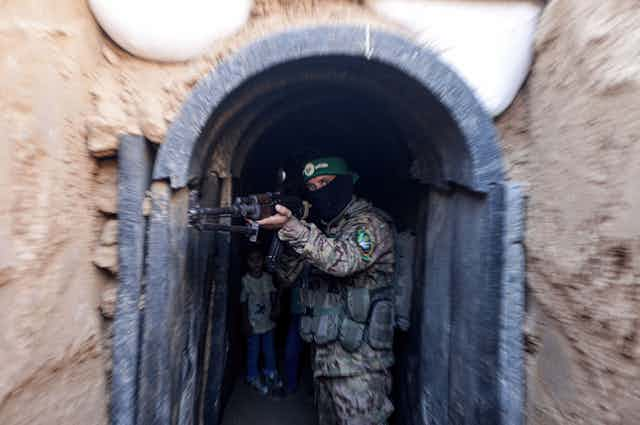Amid fears of yet another long war in the region, Israel has now begun its ground campaign in Gaza. The Israel Defence Forces (IDF) has already claimed several successes in its three-week campaign, including the elimination of several terrorist leaders including Ibrahim Biari, who it described as a “ringleader” of the October 7 attacks, and liberating at least one hostage held by Hamas.
But Israel’s military commanders will know that this is unlikely to be a simple operation. Among the factors complicating their mission of eliminating Hamas is the “Gaza Metro”, a vast network of interconnected tunnels within the region. Having invested heavily in subterranean infrastructure over the years, Hamas is counting on this network to aid its survival in the coming weeks.
Underground engineering has a long history in warfare. From antiquity to Vietnam, a range of groups have used tunnels to gain an advantage.
Not only can they provide concealment and freedom of movement, but they also present a range of challenges for the attacking force – they can be hardened against any attacks from the surface. Storming underground networks can also be prohibitively difficult for an attacker, given the limited space available.
Sometimes they work. Sometimes they don’t. For instance, the threat posed by western airpower caused Islamic State (IS) to construct a large network of tunnels. These tunnels made surveillance and airstrikes difficult and were riddled with traps, making capture by ground forces dangerous and difficult.
These benefits only really work if the tunnels are defended, of course, which wasn’t always the case. For instance, in the 2015 battle for Sinjar, the majority of IS fighters were long gone by the time Kurdish land forces arrived to liberate the city.
Established network
Hamas’s tunnel network presents a unique problem for the IDF. There have been tunnel networks in Gaza for years. Initially used for smuggling, they were quickly turned towards offensive uses, playing a role in kidnapping and weapons storage.
The Hamas subterranean networks really began to evolve after 2012, when restrictions were lifted on the importing of building materials to the region. The militant group was able to redirect construction supplies away from civilian infrastructure projects to expand its underground presence.
While the tunnels vary in quality, many are well equipped and hardened, and deep enough to evade detection by ground penetrating radar.
Unsurprisingly, key Hamas allies, including Iran are boasting about the Gaza Metro. The network provides the group with a haven and a means to move around the region unobserved.
It places leadership and organisational infrastructure out of reach from air attacks. The system is laden with supplies as well as weapons and fuel.
Defended, booby-trapped and likely to be populated with human shields and hostages as well as fighters, they will be challenging for even a well-equipped and capable attacking force.
Yet, if not addressed, Hamas may continue to operate irrespective of what happens on the surface. Indeed, as many of the tunnels lead across the border, there is a risk of further incursions, rocket strikes and attacks on IDF forces. And, given the heavily urbanised nature of Gaza, much of the network is beneath civilian infrastructure, which further complicates Israeli operations.
Hamas is a proficient and prolific user of tunnels. But in honing its expertise, the group has also provided Israeli forces with a decades-long crash course in how to deal with their underground operations.
In addition to their own experience with Hamas tunnels, the IDF can also draw upon lessons from the war on terror, where coalition forces had to contend with both natural and purpose-built tunnels, and even US experiences with drug cartels burrowing on their southern border with Mexico.
Bitter experience
While Hamas is counting on its tunnels to cause problems, Israel already has a range of solutions. It has already gained valuable experience in underground operations, having learned hard lessons from the past. A range of innovative purpose-built technologies and strategies can be used to provide the IDF with a technological edge.
Some are simple, such as flooding tunnels with sewage, whereas others are more complex, involving specialised engineering. Some solutions, such as ground-penetrating explosives, might be difficult to use, given the presence of civilians.
Israel has known about the tunnels for a long time and is taking them seriously. Recent operations suggest that the time spent training for this exact scenario is going to pay off, at least to a certain extent.
But dealing with a network of more than 300 miles is still going to represent a massive challenge, and storming or blocking off every part of the system is probably impossible.
Bitter experience has taught Israel most of Hamas’s tactics already – but this does not mean that the group doesn’t have more tricks up its sleeve. Hamas’s recent offensive success was rooted in the way it used a number of relatively low-level capabilities in concert.
For instance, paragliders, ground assaults and rockets only have a limited impact when used individually, but together, were used to devastating effect on October 7.
Now Hamas will be hoping for the same degree of success when acting on the defensive. Depending on how Israel chooses to deal with the issue, they may find their ground forces bogged down in slow-moving subterranean activity, or risk heavy civilian casualties if they simply choose to bomb or collapse the tunnels.
Almost any solution Israel chooses can be turned into a Hamas advantage: both in military and political terms.
Ultimately Israel has no perfect solution to the complex problem posed by the Hamas underground network. But years of dealing with the Hamas Metro means the IDF is not entirely unequipped to confront the challenge.
It seems inevitable that the next days and weeks will be a bitter and bloody struggle, both in the streets of Gaza and as deep as 70 metres below ground.

